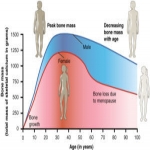Bone Density Test: Why is it important for you?

A bone density test determines if you have osteoporosis, a disease that causes a decrease in bone mass causing weaker bones with a higher risk of bone fracture. Determining your bone density can be helpful in predicting the risk of a fracture and determining the need for treatment of osteoporosis. The higher your bone mineral content, the denser your bones are. Stronger bones are less likely to break.
What is a bone density test?
A bone density test uses X-rays to measure how many grams of calcium and other minerals are packed into a segment of bone. The most commonly tested bones are located in the spine, hip, and forearm. The test is called a DEXA scan, which stands for “dual-energy x-ray absorptiometry.” It is considered the most accurate test for bone density. Scores are reported either as T-scores, which compare your bone density to the optimal peak bone density for your gender, or Z-scores, which compare your results to others of your same age, weight, ethnicity, and gender.
Who should have a bone density test?

Osteoporosis is more common in older women, although men can also develop the condition. Risk factors for osteoporosis include:
- Being female
- Advanced age
- Being Caucasian or Asian
- Being thin or having a small frame
- Sedentary lifestyle
- Family history of osteoporosis
- Estrogen deficiency
- Anorexia nervosa
- Cigarette smoking
- Excessive alcohol intake
Your doctor may recommend a bone density test if you have:

- Lost height. People how have lost at least 1.6 inches in height may have experienced compression fractures of the spine. Osteoporosis is one of the main causes of compression fractures.
- Fractured a bone. Fragility fractures occur when a bone becomes so fragile that is breaks much more easily than expected.
- Taken certain drugs. Long-term use of steroid type medications such a prednisone interferes with the bone rebuilding process and can lead to osteoporosis.
- Received a transplant. Anti-rejection drugs can interfere with the bone rebuilding process.
- Experienced a drop in hormone levels. Women experience a natural drop in hormones after menopause. They may also experience a drop in estrogen during certain cancer treatments. Lowered testosterone levels in men can also weaken bone.
What can I expect when having the test?
Bone density tests are easy, fast, and painless. There is no preparation.
If your test is done at a hospital or doctor’s office, it will probably be done on a central device where you lie on a padded platform while a mechanical arm passes over your body. The amount of radiation you are exposed to is very low, less than the amount from a chest x-ray. The test usually takes about 10 minutes.
Some testing can be done with a small, portable machine, which you may see in a pharmacy. If your test is done with a peripheral device, the machine will measure the density in the bones of your fingers, wrist, or heel. This type of measurement is not as accurate as the testing which measures your hip or spine, so if these results are positive your provider may recommend a follow-up scan.
What do the scores mean?
A T-score is your bone density compared with what is normally expected in a healthy young adult of your sex. Your T-score is the number of units, called standard deviations, that your bone density is above or below the average.
- 1 and above is considered normal.
- Between -1 and -2.5 is a sign of osteopenia, a condition in which bone density is below normal and may lead to osteoporosis.
- 2.5 and below indicates that you have osteoporosis.
A Z-score is the number of standard deviations above or below what is normally expected for someone of your age, sex, weight, and ethnic origin.
- 2 or lower may suggest that something other than aging is causing abnormal bone loss. Your doctor can diagnose and treat the condition so that bone loss is slowed or stopped.
Your provider will review your scores with you and discuss treatment plans, which may include evaluation of your diet and exercise plan, smoking cessation, medications or dietary supplements.
Strong bones are healthy bones, please take good care of yours!
written by: Suzy Cummings, RN
Kansas City Bone & Joint Clinic
Source: Mayo Clinic and About Orthopedics
image source http://commons.wikimedia.org/wiki/File:Peanut_Butter_Texture.jpg

